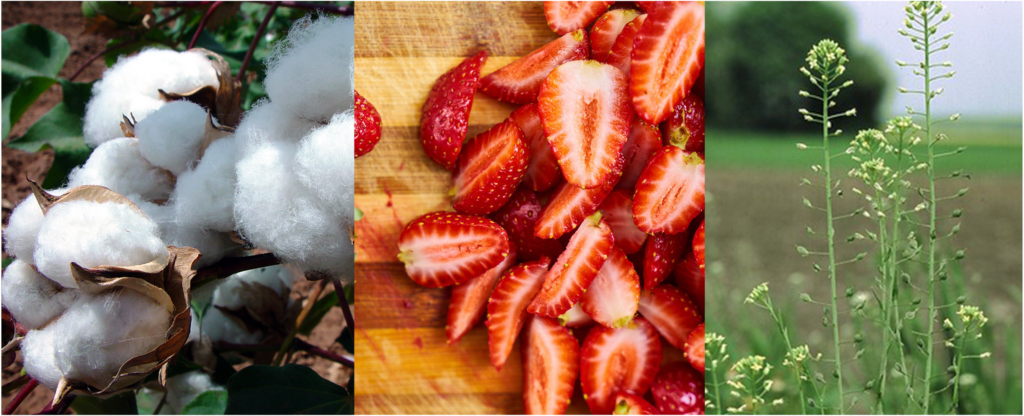
Left to right: cotton, strawberries, and Camelina sativa are among the plants to which researchers applied the subgenome identification method. (Cotton Inc., Strawberry via Pixabay, Camelina by Fornax via Wikimedia Commons, CC-SA 3.0)
In the summer of 2015, Adam Session was a postdoc working at the DOE Joint Genome Institute with Dan Rokhsar, who also holds a joint appointment with the University of California, Berkeley. Nowadays, Session is an Assistant Professor at Binghamton University in New York. He and Rokhsar have recently published a Nature Communications paper that builds off their early collaborations that could help crop breeders and researchers predict how crops and model organisms may evolve.
Determining the genetic codes of plants is often challenging because in many plants chromosomes are present in more than two copies, a condition known as polyploidy. The multiple copies arise from past genome duplication, which occurs in two basic ways. In “autopolyploids”, genome duplication occurs within a single species. By contrast, “allopolyploids” arise when different ancestral species crossbreed before genome doubling. In allopolyploids, the set of chromosomes from each ancestor is called a subgenome. Session and Rokhsar, building on work with former JGI postdoc Jarrod Chapman, developed a method to correctly identify polyploid subgenomes without needing to know the genomes of their ancestors.
The method was tested on a number of plants, including genomes of cotton lineages and the oilseed crop false flax – genomes that have been sequenced by the JGI – and the common strawberry, which is octoploid (eight copies of each chromosome). All of these genomes are available on the JGI plant portal Phytozome. “The broad applicability of the method is likely the most important, but also the ability to understand the complicated evolutionary history of strawberry in such detail is biologically interesting,” Session said.
The Kmer Subgenome Identification method can be accessed here so that, Session said, other scientists can “follow a step-by-step process to apply it to any genome of interest.” This figure outlines the general methodology he and Rokhsar came up with:
Until they came up with this new method, Session mentioned that the analysis for determining the evolutionary history of strawberries wasn’t completely accurate. “They took every single gene from octoploid strawberry, compared it to other non-polyploid strawberries, and said ‘whichever gene you’re the closest to is the one I’m going to say you evolved from’,” he said. “This approach could work if genes from all possible candidate ancestors are available. Our method clearly identifies the four subgenomes based on non-genic sequences.”
In his words, the history of the strawberry is complicated because, “when you have comparisons to other closely related species, it’s hard to analyze. The ancestors are a bit hard to identify and there’s a small possibility that something could be missing from the analysis (due to extinction or you didn’t sample it). But once we deciphered the subgenomes we came up with a simple series of events leading from multiple small wild strawberry species to the beautiful strawberries you find at the market.”
Session credited his time with Rokhsar (both during and after his time at the JGI) as a helpful influence for both developing the method and publishing the paper. “I would say there was a lot back-and-forth, y’know, over the decade that I worked with Dan to develop this specific procedure.” The rapport they built during this project and others (including the dissertation that preceded his JGI postdoc) was influential in “creating an early algorithm and developing it in order to talk about the subgenome identity.”
These days, Session is starting his lab at Binghamton “studying polyploids and transposon evolution, expanding on this kind of analysis in more species, as well as modifying this method to study other types of problems surrounding differential distribution of repeats in genomes.” He’s working with Rokhsar on a newer genome project, and enjoys the fact that he can use what they’ve developed here to further future research and answer complex questions.
Publication:
- Session AM and Rokhsar DS. Transposon signatures of allopolyploid genome evolution. Nat Communications. 2023 Jun 1. doi: 10.1038/s41467-023-38560-z
Related Links:
- Binghamton University news release: The ingredients for a strawberry: New method traces ancestry of hybrids
- Phytozome plant portal
- JGI Feature: Meet a JGI Postdoc: Adam Session
